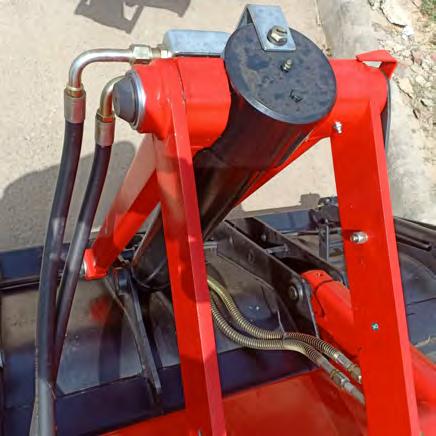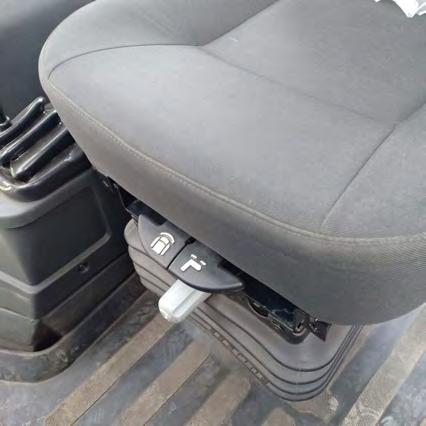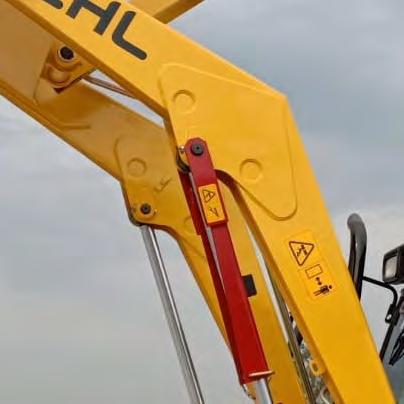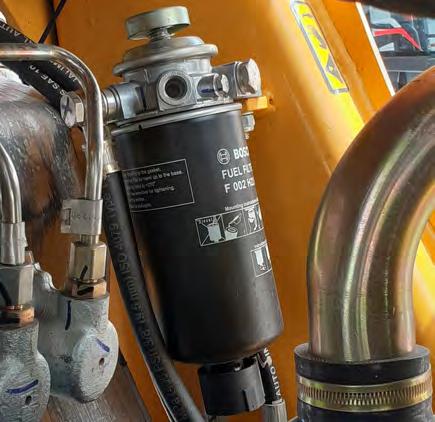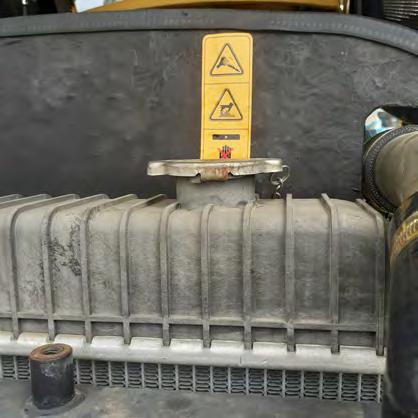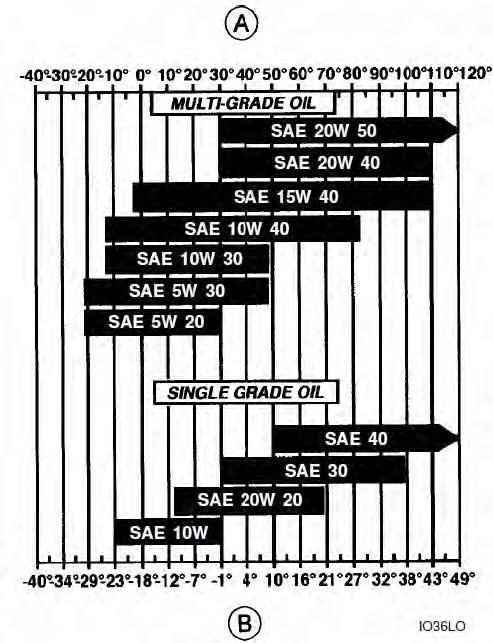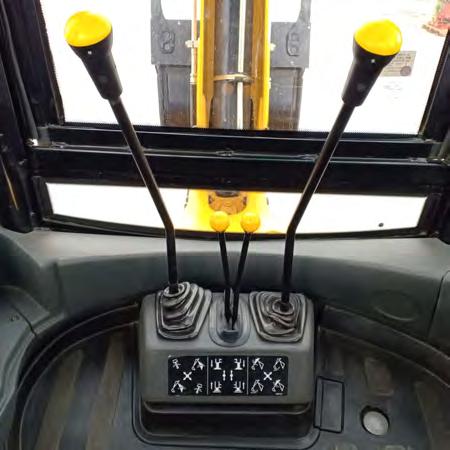
26 minute read
OPERATING AND SAFETY INSTRUCTIONS
1.1 Important Information
Manitou appreciates your choice of our product for your application. Our number one priority is user safety which is best achieved by our joint efforts. We feel you can make a major contribution to safety if you are the machine user. The installation procedure ensures that these instructions are understood. Observe the recommendations and make daily maintenance a routine.
• Comply with all the relevant National Laws and Local Regulations.
• Read, Understand and Follow the instructions in this and any other manuals supplied with this machine.
• Use Good, Safe Work Practices in a common sense way.
• Only Use Trained and Competent Operators to operate the machine who are guided by informed and knowledgeable supervision.
• Operations Manual is to be replaced immediately if lost, damaged or unreadable.
If there is anything in this manual which is not clear or there is information which you think should be added, contact the Manufacturers Service Department who will deal with your problem or request. We reserve the right to make improvements tothese machines without incurring any need to change these operating instructions.
Any modification to this machine which has not been approved by the Manufacturer in writing immediately invalidates the Manufactures warranty.
1.2 Explanation Of Symbols
The symbols shown below are used to warn of potential hazards as well as to provide useful information concerning a procedure.
Indicates an imminent hazardous situation which, if not avoided will result in death or serious injury.
Indicates a potentially hazardous situation which, if not avoided, may result in death or serious injury. Indicates a potentially hazardous situation which, if not avoided, may result in minor injury or damage to property. It is also used to warn users of unsafe practices.
Indicates any additional instructions to follow while performing a procedure.
1.3 Intended Use
The machine has been designed and tested to carry out the function of handling various free flowing materials / digging hard strata. If used correctly, it will provide an effective means of handling and meet the appropriate performance standards and regulations.
Use of this product in any other way than described in this instruction manual is prohibited and contrary to its intended use.
1.4 Right, Left, Front and Rear of the Machine
The terms “right” , “left” , “front” and “rear” , when used in this manual, indicate the sides of the machine as seen from the operator’s seat facing loader side.
Operator seat in backhoe operation position
1. Front 2. Rear 3. Left - Hand Side
4. Right - Hand Side
1.5 OperationsManual
• Immediately on taking delivery of your new backhoe and before putting it into service:
• Read this handbook completely - it could save a great • deal of unnecessary expense. Put this Instruction Manual in the storage compartment (A) on the rear of the drivers seat.
1.6 Model, Product Identification Number and Month & Year of the Machine
1. Machine
Located on the right hand side of the chassis the label is recorded with the Model, Product Identification Number and Month & Year of manufacture of your machine and the Product Identification Number (PIN) on the various hydraulic and mechanical components in the spaces provided below.

The vehicle is identified by the Product Identification Number (PIN).


1. Model
2. Product Identification Number
3. Month & Year of Manufacturing
When ordering parts, requesting information or assistance, always give your local dealer the Model/ Product Identification Number, Month & Year of Manufacturing of your machine.
Write the Model/Product Identification Number, Month & Year of manufacturing of your machine and the serial numbers on the various hydraulic and mechanical components in the spaces provided below.
2. Engine
• Engine / Type
• Rated kW/hp
• RPM
• Rating Std
• Engine Number

1.7 TotheOwner
The purpose of this Operator’s Manual is to enable the owner or the operator to operate and maintain the machine correctly and efficiently. If these instructions are followed carefully they will contribute to years of efficient and profitable operation of the machine.
The installation procedure briefs on the various checks and identification of the machine. Make sure that these instructions are understood. Observe the recommendations and make daily maintenance a routine.
The variations in operating conditions make it impossible for the company to make comprehensive or definite statements in its publications regarding performance and methods of use of its machines or to accept any liability for any loss or damage which may result from these statements, or from any errors or omissions. IT
IS THE DUTY OF THE USER WHEN TRAVELLING ON THE PUBLIC HIGHWAY TO ENSURE THAT THE VEHICLE ATTACHMENTS (IF ANY) CONFORM WITH THE LOCAL ROAD TRAFFIC REGULATIONS
Users are strongly advised to make use of the widespread network of local dealers in connection with any service problems and adjustments which may arise. Local dealers are trained and equipped for the purpose of advising users on any special problems arising as a result of local conditions, and are able to call on the Manufacturers Technical Staff for advice.
Service and Parts
When replacements are required, insist on genuine Manitou spare parts from your dealer, as extensive damage is liable to result from the use of inferior quality parts
If you require the name and address of local dealer , in any particular area, write to www.manitou-group.com
1.8 General
In accordance with the Company’s policy of continuous improvements to its machines, alterations to the specifications of machines may be made at any time without notice and the Company accepts no responsibility for any discrepancies which may occur between the specifications of its machines and the descriptions thereof contained in its publications.
This Operator’s Manual has been written to include all factory fitted options and specifications for world-wide use, but this does not imply that all or any of these options are included in the standard machine configuration. Therefore local dealers must always be consulted about machine specifications.
1.9 BulletinCompliance
• You must take action and comply with any safety bulletins transmitted to you by your dealer or by Manitou Group.
• Make sure that the details of ownership of the machine are recorded by your dealer and the information is accurate and upto date. Failure to do so may result in critical safety information being communicated.
• Bulletins can only be issued to the recorded owner or keeper of the equipment. It is your responsibility to make sure that your dealer or Manitou Group has the correct information.
• If you are the new owner contact your local dealer with your details and quote the machine PIN number to make sure you receive any future bulletins or updates.
1.10 ContactingtheManufacturer
At times it may be necessary to contact the manufacturer of this machine You should supply the Model and PIN number of the machine together with your name and contact details as a reference on contacting the manufacturer.
You must contact Manitou/GEHL dealer to:
•Report accidents involving your Manitou/GEHL equipment
• Inform updates to owner details (if not reported to Manitou/ GEHL dealer)
• Ask questions regarding product applications and safety
• Inquire of standards and regulations compliance information
• Gain approval from Manitou /GEHL regarding all product modifications.
1.11 TransferofMachineOwnership
If you sell or otherwise dispose of your machine you must tell your dealer or otherwise Manitou Group the following details:
• The name and address of the new owner
• The model and PIN number of the machine
• The date of transfer or disposal
1.12 Equipment Start - up Certificates
NOTE
Equipment Start-up Certificate for Safety Alert or Recall Only.
We will use the information provided on this start - up certificate card only to contact you if there is a safety alert or recall for this product. We will not sell, rent, or share your personal information.
If you register on this Web (Web: www.manitou-group.com) site you do not need to fill out the registration card that came with your equipment.
1.13 WarrantyandMaintenance
The warranty period for the machine, under normal circumstances, covers the first 12 months of use. This period begins the day the machine is handed over or put into operation. The machine must be used correctly and serviced to the manufacturers recommendations. The correct grades of fuels, lubricants and coolants must be used at all times and must be new and clean when added to the machine . Failure to follow these rules may lead to failure of the machine. Servicing and repairs must be carried out by the dealers staff who are trained and experienced in the necessary skills for successful maintenance of the machine.
Only genuine Manitou spare parts must be used when the machine is serviced or repaired. All claims during the warranty period will only be accepted if the recommended maintenance and service work has been carried out at the specified intervals.
It is important that regular maintenance and service work is carried out after the warranty period has expired to make sure the machine is in good working condition and does not cause unnecessary downtime and expense. Modification of this machine and/or changes to the specification which have not been approved by the factory, will invalidate the machines warranty and possibly your own insurance cover.
1.14 Service and Replacement parts Inquiries
Please state the Product Identification Number (PIN) when making inquiries or orders and in written correspondence.
This safety section covers a wide variety of hazardous situations, (but not necessarily limited to those described), which may or may not apply to any specific machine installation. They are given for general guidance only to assist the operator in setting up and maintaining an appropriate regime for the protection of health and safety. Wherever the machine is supplied for incorporation into plant/equipment designed, supplied and located by others, Manitou Group cannot be aware of particular hazards that may be present or might occur and therefore accept no liability for addressing or resolving these issues.
2.1 GeneralSafety
1. Safety Alert Symbol
The Safety Alert Symbol is used to alert you to potential personal injury hazards. Obey all safety messages that follow this symbol to avoid possible injury or death.
2. Property Damage
The following signal word indicates a risk of property damage.
NOTE
NOTICE - is used to address practice s not related to personal injury.
3. General Safety Notes
Consult manufacturer or dealer for details of training courses.All the time you are working on or with the machine you must be thinking what hazards there may be and how to avoid them.
This manual is designed as a guide to the Machine’s Controls, Operation and Maintenance. IT IS NOT A TRAINING MANUAL.
NOTE
This manual must not be removed from the machine and should be kept in the place provided in a usable condition.
If the manual becomes unusable, or additional copies are desired, new copies may be ordered from the manufacturer by quoting the Publication Number.
All Operators of the machine must be authorized, mentally and physically capable of operating this machine and fully trained and competent in its operation. The Operator must have read and understood this manual before operating this machine. Only authorised persons should be allowed to op-erate this machine. Unauthorized use of this machine may invalidate the insurance and warranty cover.
If you are unsure of anything concerning the machine or job- ask the Manitou /GEHL dealer
2.2 PersonalProtectiveEquipment(PPE)-CanopyandCabVersion
The following symbols indicate the personal protective equipment that must be used at all times when operating this equipment. Operators should not wearrings scarves, open jackets and should ensure that all loose clothing is tightly secured. Long hair should be restrained.
The following symbols indicate the personal protective equipment that must be worn, whilst performing maintenance on the machine, when conditions dictate.
The following symbols indicate the personal protective equipment that must be worn when site conditions dictate when operating this equipment.
Symbol Description
Safety Glasses
Ear Defenders
Safety Boots
Seat Belt
Protective Clothing
Protective clothing must be worn when site conditions dictate
Protective Gloves
Wear protective gloves to prevent injury from sharp objects when site conditions dictate.
Face Mask
A face mask must be worn to when site conditions dictate prevent eye or facial injury from flying objects.
Dust Mask
A dust mask must be worn when site conditions dictate.
Respirator
A respirator must be worn when site conditions dictate.
High Visibility Clothing
High Visibility Clothing must be worn when site conditions dictate.
Protective Helmet
Protective Helmet must be worn when site conditions dictate to prevent injury from falling objects.
2.3 Safety Instructions
Your safety and that of people around you depends on you. It is essential that you understand this manual for the correct operation, inspection, lubrication and maintenance of this machine.
Read this manual carefully and check that:
You understand fully the symbols on the controls and the safety signs used in this manual and on the machine. You understand fully the speed, stability, braking and steering characteristics of themachine. If you are in any doubt, consult your local dealer.
The safety messages in this section concern situations which may arise during normal machine operation and servicing. These safety messages also indicate the different ways of coping with these situations. Other safety messages are used throughout the manual to indicate specific hazards.
Whatever type of work is concerned (earth moving, handling, etc.), the safety arrangements applicable to private or public job sites are those which correspond to the regulations in force in the country and in the trade concerned (example : mining, quarries, underground work) must be adhered to. Evaluate the specific jobsite where the machine is to be used and address any risks specific to that jobsite not covered in this operators manual.
The information given in this chapter is a summary of the basic rules to respect at all times and does not exempt you from observing traffic regulations or the requirements of insurance companies. Always keep this manual in the storage compartment provided for it. Make sure that it is always complete and in good condition. Consult your local dealer to obtain extra manuals. All by standers must be made aware of all potential safety hazards caused by operation of this machine and the precautions to be taken to avoid injury.
2.4 Electrical / Lightening Storm
When lightning is striking in the vicinity of the machine, the operator should never attempt the following procedures:
• Mount the machine.
• Dismount the machine.
If you are in the operator’s station during an electrical storm, stay in the operator’s station. If you are on the ground during an electrical storm, stay away from the vicinity of the machine.
2.5 Before Using the Machine
1. On Road and Job Site
• Read and ensure that you understand the instructions and warnings given in this manual before operating the machine.
• The presence of grease, oil, mudorice on the steps and access handles can cause accidents. Make sure they are always clean.
• Position and adjust the rear view mirrors to correct position.
• Remove anything which might hinder visibility. Clean the windshield, windows (cab version) and rear view mirrors.
• Before travelling or working at night, check that the lighting and signalling systems are operating correctly.
• Make sure the doors (cab version) and the engine bonnet are correctly fastened before undertaking any travel.
• Make sure that no loose object or tool is left on the machine or in the operator’s compartment.
• The operator should be the only person on the machine. Make sure there is nobody on or near the machine.
• When mounting or dismounting from the machine always face the machine and use the steps and access handles on the left-hand side of the machine. The right hand side is to be used only in case of emergency.
• Be prepared for emergencies. Always keep a first aid kit and a fire extinguisher secured on the machine. Make sure that the fire extinguisher is serviced in accordance with the manufacturer’s instructions.
• Make sure that you fully understand the location and function of every control. Operating the controls wrongly can cause serious physical injury.
• Always fasten your seat belt before starting the engine. The seat belt will protect you efficiently if you attach it correctly and if you always wear it. The seat belt should not be too loose. It must not be twisted or caught in the seat.
• Make sure you know ways of getting out of the machine (emergency exit via the right-hand side) in case the machine falls over or if access via the left hand side is not possible. Make sure that the right hand door (cab version) is not locked.
• Check the condition and pressure of the tyres regularly.
• The integrity of the vehicle electrical installation is paramount to the machine’s performance, hence in no uncertain terms should the electrical system be modified without written consent from the manufacturer’s engineering department. Fitment of any auxiliary loads is restricted to the available power sockets only.
• Before operating the machine the operator should carry out the daily inspection as outlined in the General Inspection, see “Standard Operating Procedure Before Machine Operation” section.
2. Road Operation
NOTE
It is mandatory to make sure that the brake pedals are locked together before any road travel or travel in 3rd or 4th gear. If this instruction is not observed an accident may occur.
Check that both the cab doors (cab version) are closed correctly before undertaking any road travel. Before undertaking any road travel, lock the working attachments and install the safety systems required by regulations. Raise the stabilizers completely.
Before undertaking any road travel, make sure to lock the left and right brake pedals together.
3. On the Job Site
• Operating the machine requires your full attention. Caution on the part of the operator can prevent accidents. Make sure you know the capabilities and limits of the machine and the space needed for it to operate. If there are areas of poor visibility in the machine’s working range; have someone to guide you for all jobs which have poor visibility.
• Check all around the machine every day to ensure there are no oil leaks or hydraulic fluid leaks. Tighten connections as necessary and replace any parts as required.
• Make sure you know the hand signals used on your job site so that youcan be guided when making delicate manoeuvres or for work where direct visibility is not available.
• Check that all the controls and all the safety devices operate correctly in a safe, clear area before beginning work.
• Keep away from dangerous areas such as ditches, over-hangs, soft areas, etc. Walk around the work site before using the machine and look for hazards.
• Inspect and note all possible risks before driving the machine into a new working area. Holes, obstacles, debris and other hazards in the working area can cause serious injury.
2.6 Operating the Machine
1. On Road and Job Site
• Do not allow anyone to climb onto the machine. A passenger can fall or cause an accident.
• Never operate any of the machine’s controls unless you are seatedcorrectly in the operator’s seat.
• Adapt your driving style to suit the conditions of work (sloping ground or rough ground), the state of the road and weather conditions.
• Use all the controls gradually so that the machine works smoothly.
• Engage the parking brake, stop the engine, and remove the starter switch key even for stops of short duration.
• Never leave the operator’s compartment when the engine is running.
• When entering or leaving the operator’s compartment, it is essential that the loader attachment controls (ifequipped) are locked. Never try to by-pass this basic safetyrequirement.
• Dust,smokeor fog can reduce visibility and cause an accident. Stop the machine or slow down until visibility returns to normal.
• Never jump down from the machine. When dismounting from the machine always face the machine and use the steps and access handles.
• Whenever parking the machine on sloping ground, use wheel chocks to immobilize the machine (specific to certain countries).
• Never leave the loader bucket raised without installing the safety support strut to the left hand loader cylinder.
• Never travel at full speed with the loader attachment completely raised.
• Never travel at high speed if the loader bucket hinders visibility. You could drive into a hidden object.
2. On the Job Site
• On job sites on the public highway, use regulation signals, taking into account the working range of the machine. National or local regulations define the number, type and location of reflector strips.
• Avoid running the engine in an enclosed space. If it can not be avoided, ensure good ventilation under all circumstances.
• Do not work close to live overhead electric lines without first making sure that the minimum distances are observed:
• Make sure you know the location of pipes and cables before starting work. Electrical cables, gaspipes, waterpipes or other underground installations can cause serious injury.
• Do not allow anyone to stand in the machine working area. If the operator uses the swing or attachment controls wrongly, this could cause an accident. Stop all movement until theperson has moved away.
• Before moving the stabilizers make sure that no person is within the working range of the stabilizers.
• When moving the machine on to a trailer, place the gear change lever in first gear. Keep the loader bucket 20cm (8 inch) from the ground.
• Load lifting must be carried out in accordance with the instructions shown in this manual and in accordance with current regulations.
• Before using the backhoe attachment make sure that the machine is clear of the ground by means of the stabilizers and the loader attachment.
• Any uncontrolled movement of the machine can cause an accident. Before turning the operator’s seat to the backhoe attachment working position, it is essential to place the direction of travel control lever and the gear change lever or the transmission control lever (Servo Power synchro machines) in the neutral position and to immobilize the machine by means of the parking brake lever.
• If you are using the backhoe attachment or if you are carrying out maintenance operations, use the engine throttle lever. Theuse of the lever for any other operations can cause accidents.
• In case of any operational problem or damage, move the machine to a place of safety, lower the loader attachment and the backhoe attachment to the ground, stop the engine, engage parking brake, and remove the starter switch key. Find the cause of the defect or inform responsible personnel. Take measures to prevent the use of the machine.
• When the machine is being lifted, nobody must be allowed to remain in the area surrounding the machine.
3. Parking the Machine
When you park the machine, proceed in the following manner:
1. Park the machine on a flat, level surface away from any soft ground, excavations or poorly shored cavity.
2. Lower the loader bucket until it is pressing on the ground.
3. Lock the loader attachment by means of the control locking lever (if equipped).
4. Place the direction of travel and gear change levers or the transmission control lever (Servo Power synchro machines) in the neutral position.
5. Engage the parking brake.
6. Place the backhoe attachment in the road travel position. See “setting the Backhoe Attachment in the Road Travel Position” section.
7. Raise the stabilizers completely.
8. Stop the engine and remove the starter switch key. See “Stopping the Engine” section.
9. Release the hydraulic pressure by operating control levers in all directions. See “Releasing the Pressure in the Hydraulic System” section.
10. Raise the bonnet and disconnect the electrical system by means of the battery isolator switch key.
11. Close and lock the bonnet.
12. Make sure that the windows (cab version), and the engine bonnet are correctly fastened and lock the operator’s compartment doors (cab version).
13. If the machine is parked outdoors, cover the exhaust pipe so as to protect the engine against damp.
14. Check that no part of the machine is protruding onto the public highway. If this can not be avoided, install signs in accordance with regulations.
2.7 Emergency Operating Procedures
1. Prevention of Burns
Battery electrolyte causes severe burns. The battery contains sulfuric acid. Avoid any contact with the skin, eyes or clothing.
Antidote:
EXTERNAL: Rinse with water.
INTERNAL: Drink large quantities ofwater or milk. Then drink milk of magnesia, a beaten white of an egg or vegetable oil. Call a doctor immediately.
EYES: Rinse with water for 15 minutes and consult a doctor quickly.
When the electrolyte of a battery is frozen, it can explode if you attempt to charge the battery or if you try to start the engine using a booster battery. Always keep the battery charged to prevent the electrolyte freezing. Batteries produce explosive gases. Keep all flames, sparks and cigarettes away. Provide good ventilation when changing a battery or using a battery in an enclosed space. Always protect your eyes when working near a battery. Boiling coolant solution can spray out if the radiator cap is removed while the system is still hot. To remove the cap : allow the system to cool down, turn the cap to the first notch and wait until there is no more pressure. Then remove the cap.
2. Prevention of Fire or Explosions
• Engine fuel can cause an explosion or afire.
• Never re-fuel when the engine is running.
• Do not smoke during re-fuelling.
• Take all the necessary safety measures when welding, grinding or when working near a naked flame.
• Use a non-inflammable product for cleaning parts.
• A spark or flame can cause the hydrogen in or around a battery to explode. To prevent any risk of explosion, observe the following instructions:
• Remove the battery masterswitch key (if equipped).
• When disconnecting the battery cables, always disconnect the negative (-) cable first.
• To reconnect the battery cables, always connect the negative (-) cable last.
• Never short-circuit the battery terminals with metal objects.
• Do not weld, grind or smoke near a battery.
• Remove battery isolator key if leaving the backhoe unattended.
• The electrical system or the engine exhaust may produce sparks. Before using the machine in an area which may contain inflammable vapors, ensure that there is good ventilation.
• Always keep a fire extinguisher secured on the machine. Make sure that it is properly maintained in conformity with the manufacturer’s instructions.
• Clean the machine regularly, remove all debris and material which may catch fire.
• Check for leaks. Replace damaged hoses, pipes and unions. Clean the machine after any repair work before operating it.
3. Fires NOTE
•Do not use water to extinguish a machine fire.
•Using water to extinguish an oil fire could spread the fire or give you a shock from an electrical fire.
•Use a carbon dioxide, dry chemical or foam extin-guisher whilst waiting for the fire brigade.
•Keep fire extinguisher serviceable and have it checked regularly.
•Extinguish with carbon dioxide, dry chemical or foam.
4. First Aid -Oil
A. Swallowing Oil
If oil is swallowed, do not induce vomiting. Get Medical Advice
B. Skin Contact
In the case of excessive skin contact, wash with soap and water.
C. Eye Contact
In the case of eye contact, flush with water for 15 minutes. If the irritation persists, get medical attention.
D. Oil or Fuel Spillage
Absorb with sand or a locally approved brand of absorbent granules. Scrape up and dispose of in a chemical disposal area.
2.8 Maintenance and Adjustments
• Do not carry out any maintenance operations until you have read and understood the instructions and warn-ings given in this manual.
• Wear suitable clothing when servicing the machine.
• When servicing the machine, place a “Do not start up”label on the instrument panel.
• Always wear eye protection when using a tool which might projectmetal particles. Use a hammer with a soft face, such as copper, for installing pins.
• Incorrectly performed maintenance or adjustments can cause serious injury. If you do not understand a maintenance or adjustment procedure, consult your local dealer.
• If the attachment is raised or the machine moves when there is no operator, serious injury can result. Before carrying out any maintenance on this machine, proceed in the following manner:
1. Park the machine on flat, level ground.
2. Lower the loader and backhoe attachments until they are resting on the ground.
3. Engage the parking brake.
4. Stop the engine and remove the starter switch key.
5. Lock the loader attachment controls (if equipped).
6. Block the wheels to prevent any machine movement. If a servicing operation requires the loader attachment to be raised (e.g. working on the engine), install the loader attachment support strut.
7. Removing the battery isolator key from the switch is recommended, especially when carrying out work on the electrical system.
• Unauthorized modifications of the machine can cause serious injuries. Do not carry out any modification on this machine without obtaining prior authorization from your local dealer. Any modification carried out must be in conformity with the machine’s technical specifications and must conform to current safety regulations.
• Do not carry out any welding operation on the machine without prior authorization from your local dealer.
• Some of the machine’s components are subject to type approvals. It is mandatory when replacing those components to ensure that they are in conformity with regulations. For safety’s sake, always use genuine Manitou parts.
• Hydraulic fluid or grease under pressure which penetrates the skin can cause serious injury. Take the necessary safety precautions (protective clothing and face and hand protection) to prevent all such risks. In addition, before handling these products, read the manufacturer’s specific instructions for their use. If hydraulic fluid penetrates the skin a doctor must be called immediately.
• When carrying out a welding operation on the machine, disconnect the alternator plug, battery, Transmission ECU (if equipped) and connect the welding set earth lead to the component on which the welding is to be carried out. Never connect the earth lead to a hydraulic system component. Make sure that welding operation is as authorized by the manufacturer and in accordance with his specifications.
• A burst tyre can cause serious injury. Regularly check the condition of tyres and always observe the inflation pressures defined in accordance with the type of tyre and ground concerned.
• When checking tyre pressures or during an inflation operation, never stay facing the tyre but always facing the tread surface. Always use an inflation cage when the wheel is removed from the machine. Keep all other persons away from the area. Never weld near a tyre. It is essential to remove the tyre before any welding operation.
• Take the necessary safety measures to protect your face when using compressed air.
1. Fluid Levels
Ensure the machine is on level stable ground, gear lever is in neutral and the engine is stopped when checking ALL fluid levels.
2. Frozen Battery Electrolyte
NOTE
•Do not use a machine with frozen battery electrolyte
•Batteries with frozen electrolyte may explode if used or charged.
•Never‘jump start’a machine with a frozen battery.
• To help prevent freezing, keep the battery fully charged.
3. Water Cooled Engines
Note
Never maintain cooling system when the engine is HOT.
Water cooled systems operate underpressure to increase the boiling point of the coolant. Therefore, the coolant temperature may be greater than boiling water at standard atmospheric pressure (100 ºC or 212ºF).
4. Lubricants
Note
It is essential that anyone concerned with lubricants read and understand the following text.
5. Hygiene
Lubricants are not a health risk when used correctly for their intended purposes. However, excessive or prolonged skin contact can remove the natural fats from the skin, causing dryness and irritation. Low viscosity oils are more likely to do this, therefore particular care is necessary in handling used oils which have been diluted by fuel contamination.
Whenever handling oil products, maintain good standards of care plus personal and plant hygiene. Wear oil resistant gloves when contact with lubricants is likely to occur. For details of these precautions we advise you to read the relevant publications issued by your local health authority.
6. Storage
ALWAYS keep lubricants out of reach of children. NEVER store lubricants in open or unlabeled containers.
7. Handling Oil
See “First Aid - Oil” section.
1. New Oil
There are nospecial precautions needed for the handling or use of new oil other than the normal care and hygiene practices.
2. Old Oil
NOTE
Used crankcase lubricants contain harmful contaminants. In laboratory tests it was shown used engine oils can cause skin cancer.
Observe the following precautions:
• Avoid prolonged, excessive or repeated skin contact with used engine oil.
• Wear oil resistant gloves or apply a barrier cream to the skin, before handling used engine oil.
Note the following when removing engine oil from the skin:
•Wash skin thoroughly with soap and water. Using a nail brush will help.
•Use special hand cleansers to help clean dirty hands.
•Never use petrol, diesel fuel or kerosene. Avoid skin contact with oil soaked clothing. Do not keep oily rags in pockets.
•Wash dirty clothing before reuse. Throw away oil soaked shoes.
8. Seat Belt
Note
•Failure to properly inspect and maintain a seat belt can result in death or serious injury in the event of an accident.
•The seat belt MUST be worn at all times when operat-ing this equipment.
•A seat belt is provided for operator safety, it must be worn at all times the machine is in use.
•It is important that the seat belt is inspected and checked regularly see maintenance section.
Description of Symbols and Pictorials Used on Safety Signs
Symbol Description
Read and understand this Operations Manual and all safety instructions before operating this machine.
Fasten the seat belt before operating the machine and keep it secure at all times
Falling Hazard. Falling from the machine could result in death or serious injury.
Crush Zone. Machine movement could result in death or serious injury.
No passengers/hangers on the machine. Do not allow passengers to hold on to, stand or ride on the machine.
Danger, possibility of death, serious burns or blindness due to contact with corrosive acid.
Entanglement Hazard. Contact with rotating parts could result in death or serious injury. Keep away from fan and belt when engine is running.
Danger, possibility of death, serious burns or blindness due to explosive gasses.
Loader Prop. Secure loader arm locking device before service.
Oil Injection Hazard. Escaping fluid under pressure can penetrate skin.
Stay away from the machine. Contact with a moving machine could result in death or serious injury.
Do not use your hand to check for leaks. Use a piece of paper or cardboard.
?000KG
Lift Point.
Crush Hazard. Crushing could result in death or serious injury.
Stop the engine and remove the start key before servicing
Burn Hazard, contact with hot surfaces may cause burns.
Danger of entanglement in rotating drive lines and rotatingshafts.
Crush Hazard. Machine movement could result in death or serious injury.
Keep clear of rotating parts. Contact with rotating parts could result in death or serious injury.
Rollover Hazard. Incorrect loader position when operating could result in death or serious injury.
Safety Signs

2.10 Decals
Safety signs are designed and fitted to the machine to warn of possible dangers, and MUST be replaced immediately if they become unreadable or lost. If the machine is repaired and parts have been replaced on which safety signs were fixed, be sure new safety signs are fitted before the machine is put into service. Use mild soap and water to clean safety signs - DO NOT use solvent based cleaners, as they may damage the safety sign material.
Note
An illegible or missing decal can have far-reaching conse-quences. Check them everyday. Make sure that all decals are perfectly legible. Clean them regularly, replace them with new decals if they are damaged, missing or painted over. If there is a decal on a part that is replaced, make sure you install a new decal on the new part.
NOTE : You can obtain new decals from your local dealer; the part numbers are shown at the bottom of the decal. This section concerns only those decals connected with safety, operation and maintenance of the machine. To see all the decals which exist on the machine, consult the spare parts catalogue. When replacing a decal, make sure it is placed in its correct locations.

4.
This decal shows that no operation should be carried on the fan or the fan belt while the engine is running.







This decal shows that the operator must not permit any person to remain within the working area of the backhoe attach-ment.

This decal shows the tie-down points to be used when transporting the machine. Never use any other tie down points than those shown on this decal.





This decal shows that the radiator should never be touched nor should the radiator cap be removed while the cooling system is still hot.
This decal shows that it is mandatory to read the Operator’s Manual before using





This decal shows the operation of boom lock lever.



16. Engine Starting

This decal warns that it is forbidden to start the engine by any other means than with the starter switch key.



This decal shows that the exhaust pipe should not be touched while en it is still hot.

This decal shows that it is mandatory to use the safety strut when working under the loader arm .





This decal shows the operation of FNR lever.









2.11 HAND SIGNALS
When operating the machine, never attempt to carry out tasks calling for fine control or to work in areas where visibility is poor or impaired without seeking the assistance of a signal man. Make perfectly sure that you and the signal man understand the signals to be used.
Start the Engine
Stop the Engine
Go this for
Come to me
Move hands forward and rearward (palms in).
Move away from me
Move hands forward and rearward (palms out).
All stop and hold
Emergency stop
Move both hand palms down rapidly back and forth.
Raise Load or Bucket slowly
Lower Load or Bucket slowly
Raise Backhoe Boom
Lower Backhoe Boom
Turn Machine Left
To stop movement, stop moving hand and make a fist.
Turn Machine Right
To stop movement, stop moving hand and make a fist.
Backhoe Dipper in
Retract Extendable Dipper (Optional)
Extend Extendable Dipper (Optional)

